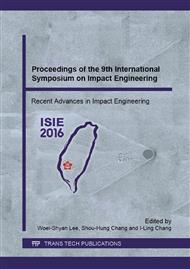p.3
p.13
p.23
p.27
p.33
p.39
p.43
p.48
Evaluation of Dynamic Properties of Wood-Plastic Composites Using Split Hopkinson Bar Methods
Abstract:
Wood-plastic composites (WPCs) which consist of wood flour and plastics have been widely used as architectural materials for a long time. However, the impact resistance is not always high and basic mechanical properties at high strain rate are not fully understood. In order to clarify the tensile behavior at high strain rates, split Hokinson pressure bar method was used for WPCs consisting of polypropylene. The effects of mixing ratio on the maximum stress and elongation at break were examined at high strain rates.
Info:
Periodical:
Pages:
23-26
Citation:
Online since:
September 2016
Authors:
Price:
Сopyright:
© 2016 Trans Tech Publications Ltd. All Rights Reserved
Share:
Citation:


